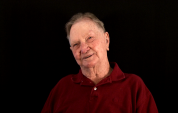8:04 | In the prison camp, Clyde Burnette only saw one American shot by the guards, a man who snapped and started climbing the wire. In the infirmary, a Yugoslav prisoner invited him along on an escape, but Burnette had to return to the general population and he missed his chance to try to make it to Italy, where his brother was posted. The camp was Stalag 17B and it became famous after the war when a prisoner wrote the story which became a well known Hollywood film.

They told Clyde Burnette that if he enlisted instead of waiting for the draft, he could pick his specialty school. He held out for aircraft maintenance school while they tried to make him accept others, and was soon training as an engineer and gunner on heavy bombers.
The score from the color-coded bullet hits on the target showed he had no hits, until they found out the scorer was color blind, recalls B-24 gunner Clyde Burnette. He was on a model crew, held back to wait on new aircraft, but the men got tired of waiting and volunteered for combat. It got his attention when he was designated a ball turret gunner, yet never saw a ball turret in training, even as he arrived in England.
The ball turret was "the worst torture chamber ever," according to Clyde Burnette. He was very happy when the bombing mission didn't call for it and he could man a waist gun instead. Wherever he was positioned in the plane, it was cold, so cold that layer upon layer of clothing was necessary.
On his first bombing mission, B-24 Gunner Clyde Burnette saw another aircraft explode in mid-air. One man got out but his parachute was in flames. It was a sobering introduction to combat. He recounts some other close calls, including the time they had to return with a payload of special 2,000 pound Blockbusters and broken landing gear.
B-24 crew member Clyde Burnette walks us through a typical mission for the airmen stationed in England and flying missions against Nazi targets. It took an incredibly complex ballet of men and machines just to get hundreds and sometimes thousands of aircraft in formation to start the mission.
It was their third mission over Berlin and they were heading home. Four German fighters pounced on the B-24 and it was engulfed in flame and going down. Clyde Burnette fought for consciousness as the other crew in the back of the plane bailed out. He woke in free fall with no idea how he had made it out, and soon he was in German custody. Everyone made it out of the plane except George "Danny" Daneau, the nose turret gunner, who went down with the aircraft.
Captured airman Clyde Burnette says his German interrogator spoke better English than he did and already had a complete dossier on him. He kept quiet and was soon in a prison camp where all anyone could think about was food and the lack of it. There were hi-jinks, like throwing rocks at the commandant's plane, disappearing infantry, and the sergeant who was really a doctor.
The Red Cross parcels were supposed to augment the food provided by the Germans but it became the primary food source for the American airmen in Stalag 17B. Clyde Burnette describes how they kept distracted from the hunger, including making some homemade booze from raisins and holding rat races in the barracks. When a prisoner stole food from another, the punishment was harsh and memorable.
When the guns of the approaching Russians could be heard, the German guards emptied the prison camp and marched the allied prisoners westward across Austria. Clyde Burnette waited in the woods where they were left by the guards until a lone American tank rumbled up.
Liberated and well fed once again, ex-POW Clyde Burnette tried to return to the States with his unit, but his records were gone when he got to England so he had to wait. He had a space on the Queen Mary, but was bumped by officers so he wound up crossing the Atlantic on an LST. A small reward was once again getting billeted in a hotel in Miami Beach.
The mission was photo reconnaissance and Clyde Burnette maintained the modified F-51's that flew the daily flights over North Korea. It was a miserable place to work, he recalls, as they had to maintain the aircraft with no hangars or sheds, just tents for shelter.
Continuing his Air Force career after the war in Europe, Clyde Burnette became a flight engineer ferrying retired aircraft. After a short discharge and reenlistment, he served in the Berlin Airlift. When they asked for a position check on one flight near the East German border, they didn't get a position but they were told to immediately make a 180 degree turn.
After serving in World War II and the Korean War, Clyde Burnette was stationed in the Philippines as the Vietnam War began to heat up. He nearly got sent there but returned to the States to finish his career which included prepping aircraft for possible use in the Cuban Missile Crisis.